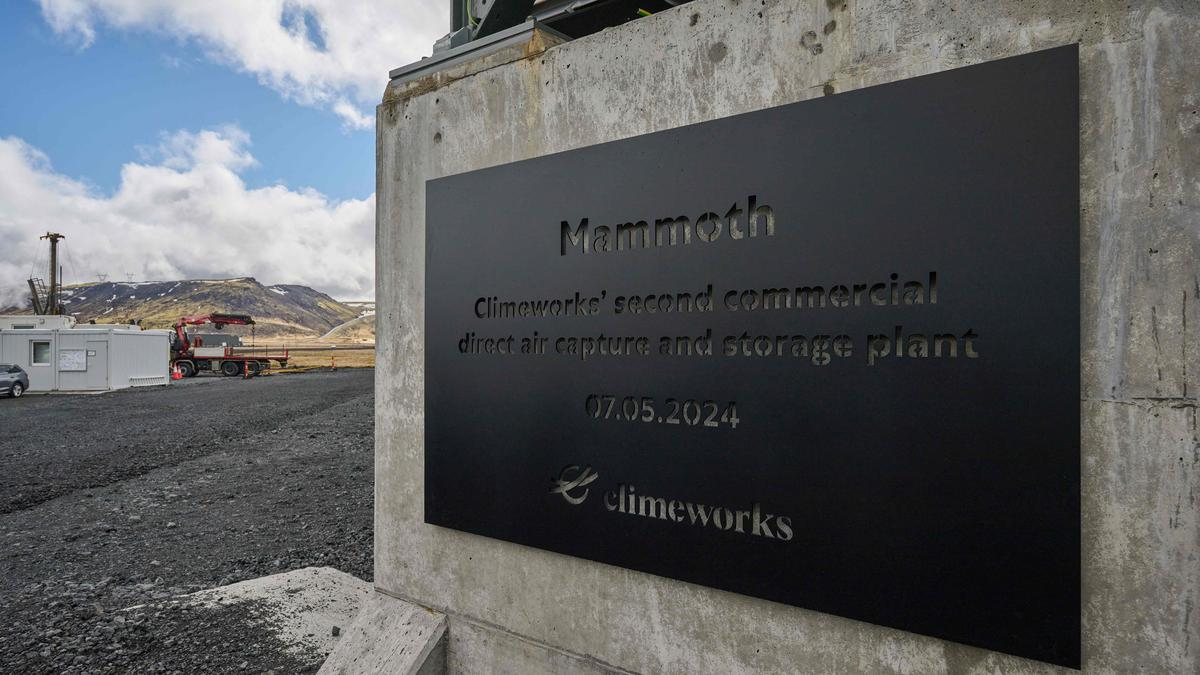Description

Disclaimer: Copyright infringement is not intended.
Context:
- Climeworks breaks ground in Iceland to build its newest and largest direct air capture and storage facility, called Mammoth.
Mammoth
- Mammoth is the largest carbon dioxide capture and storage facility of its kind, situated on a dormant volcano in Iceland.
- It is started by Swiss start-up Climeworks.
- Mammoth's has 72 industrial fans.
- This intends to suck 36,000 tonnes of CO2 from the air annually to bury underground.
- The plant is designed for a capacity of up to 36,000 tons per year. The actual net removal will be lower.
- This plant is Climeworks' second commercial direct air capture (DAC) facility in Iceland and is larger than its predecessor, Orca, which began in 2021.
What is Direct air capture (DAC)
- Direct air capture is the use of chemical or physical processes to extract carbon dioxide directly from the ambient air.
- If the extracted CO2 is then sequestered in safe long-term storage (called direct air carbon capture and sequestration (DACCS)), the overall process will achieve carbon dioxide removal and be a "negative emissions technology" (NET).
- After the capture, DAC generates a concentrated stream of CO2 for sequestration or utilization or production of carbon-neutral fuel.
Process:
- Carbon dioxide removal is achieved when ambient air makes contact with chemical media, typically an aqueous alkaline solvent or sorbents.
- These chemical media are subsequently stripped of CO2 through the application of energy (namely heat), resulting in a CO2 stream that can undergo dehydration and compression, while simultaneously regenerating the chemical media for reuse.

Difference with carbon capture and storage (CCS)
- The carbon dioxide (CO2) is captured directly from the ambient air; this is contrast to carbon capture and storage (CCS) which captures CO2 from point sources, such as a cement factory or a bioenergy plant.
Direct air carbon capture and storage (DACCS or DACS)
- When combined with long-term storage of CO2, DAC is known as direct air carbon capture and storage (DACCS or DACS).
- It would require sustainable energy to power since approximately 400kJ of energy is needed per mole of CO2
- DACCS can act as a carbon dioxide removal mechanism (or a carbon negative technology), although as of 2023 it has yet to be integrated into emissions trading because, at over US$1000, the cost per tonne of carbon dioxide is many times the carbon price on those markets.
- DAC was suggested in 1999 and is still in development. Several commercial plants are planned or in operation in Europe and the US.
Significance of DACCS:
- In contrast to carbon capture and storage (CCS) which captures emissions from a point source such as a factory, DAC reduces the carbon dioxide concentration in the atmosphere as a whole. Thus, CCS is recommended for large and stationary sources of CO2 rather than distributed and movable ones. On the contrary, DAC has no limitation on sources.
Watch the mammoth facility video:
https://climeworks.com/plant-mammoth
Source:
https://www.thehindu.com/sci-tech/science/icelands-mammoth-raises-potential-for-carbon-capture/article68160386.ece
|
PRACTICE QUESTION
Q. Assess the role of carbon capture technologies in mitigating climate change and achieving global emission reduction targets. Also discuss the various methods and challenges associated with carbon capture, utilization, and storage (CCUS) initiatives. (250 words)
|












